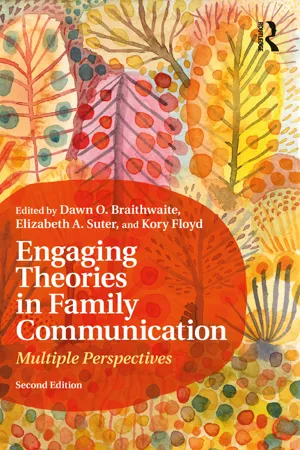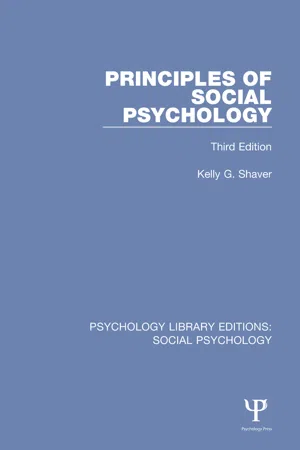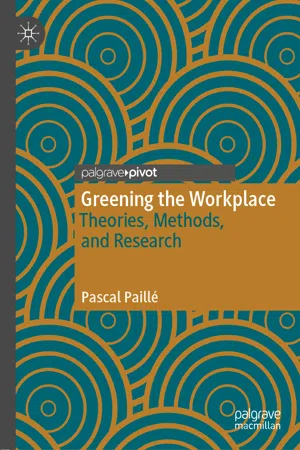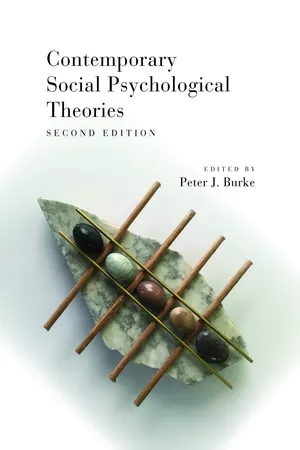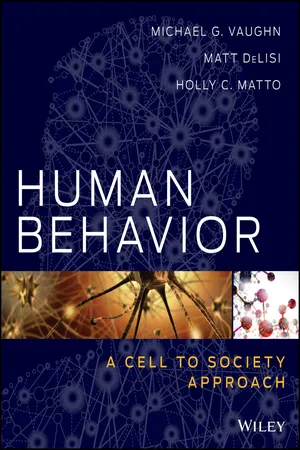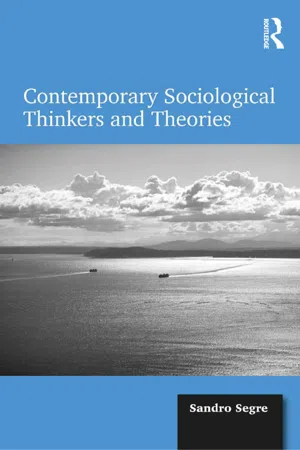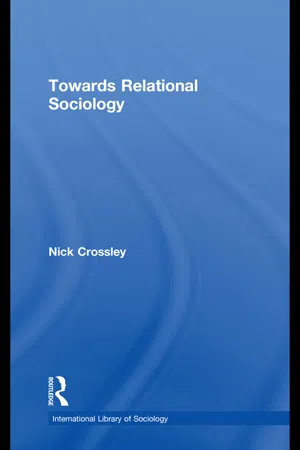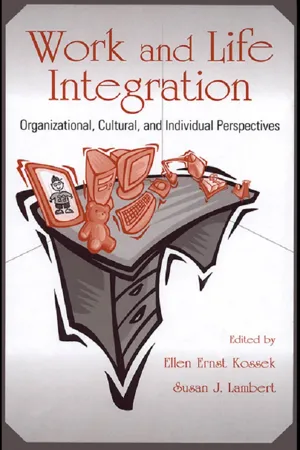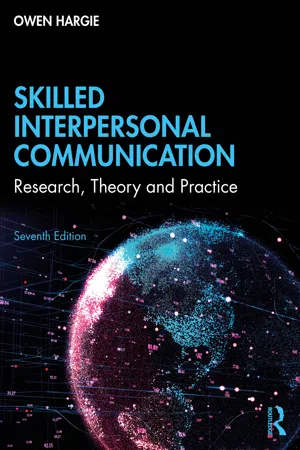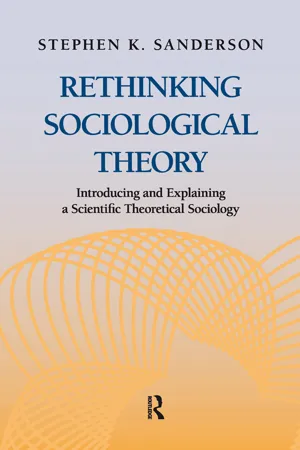Psychology
Social Exchange Theory
Social Exchange Theory is a psychological concept that posits individuals engage in relationships and interactions based on the expectation of rewards and costs. It suggests that people weigh the benefits and drawbacks of their relationships and make decisions accordingly. The theory emphasizes the importance of reciprocity and the idea that individuals seek to maximize their rewards while minimizing their costs in social interactions.
Written by Perlego with AI-assistance
Related key terms
Related key terms
1 of 4
Related key terms
1 of 3
11 Key excerpts on "Social Exchange Theory"
- eBook - ePub
Engaging Theories in Family Communication
Multiple Perspectives
- Dawn O. Braithwaite, Elizabeth A. Suter, Kory Floyd, Dawn O. Braithwaite, Elizabeth A. Suter, Kory Floyd(Authors)
- 2017(Publication Date)
- Routledge(Publisher)
25Social Exchange Theory A Cost-Benefit Approach to RelationshipsLaura StaffordOur relationships with family can provide many rewards. These relationships also come with costs. According to social exchange theories, the interpersonal interactions and relationships we engage in depend upon our estimates of the costs and rewards they will bring. Social Exchange Theory is not actually one theory. Rather, it is a framework for a set of related theories. A social exchange framework “refers to any conceptual model or theoretical approach that focuses on the exchange of resources (material or symbolic) between or among people” (Sprecher, 1998, p. 32). The beginnings of social exchange theories can be traced to psychologists Thibaut and Kelley (1959) and sociologists Blau (1964) and Homans (1961). Those psychologists and sociologists adopted the concepts of rewards, costs, and resources from behavioral psychology and economics. Social exchange theories expand the concepts of economics to “the notion of exchange to include all interpersonal experiences” (Foa & Foa, 2012, p. 15).Intellectual Tradition of Social Exchange Theory
Social exchange theories comprise falsifiable propositions: propositions can be found false. Thus, this group of theories is considered to be post-positivist. The overarching proposition is that people are rational beings who act in accordance with their own self-interests. People conduct a cost-benefit analysis on some level about interpersonal interactions and relationships and then, according to exchange theories, act in ways we believe will be profitable, similar to economic exchange.Main Goals and Features of Social Exchange Theory
As social exchange theories are based in social scientific principles, their main goal is to predict and explain behavior. By understanding the factors (the rewards and costs) that people consider in making decisions, we can predict and explain their behavior. These predictions and explanations are based in several key premises and concepts. - eBook - ePub
Principles of Social Psychology
Third Edition
- Kelly G. Shaver(Author)
- 2015(Publication Date)
- Psychology Press(Publisher)
Most of the research accomplished within the framework of social learning theory concentrates on the behavior of children, because it is during childhood that the vast majority of social learning occurs. But it would be a mistake to conclude that imitation ceases after a person reaches adulthood. (Consider, for example, the amount that advertisers spend on product endorsements made by famous people whose choices we are expected to imitate.) And it would also be a mistake to think that the effects of social reinforcers become substantially less pronounced as we get older. We are all susceptible to a little flattery here and there, and we become increasingly aware of the social costs incurred (and the rewards derived) from our relationships with other people. If there is any apparent change from childhood, it is that as adults, our imitation of others and our search for social rewards becomes more deliberate. This more or less conscious weighing of the social alternatives is at the heart of several theories of interaction.Exchange Theory
The fundamental assumption of various theories of social exchange is that in their interpersonal relations as well as in their own lives people will seek to maximize their pleasure and minimize their pain. We form friendships on the basis of mutual trust and support, we avoid social entanglements that we might be too costly, and we join groups that will provide us with personal rewards. The principles of social exchange are most easily described when only two people (a dyad) are involved, so our discussion of social exchange will concentrate on the theory of dyadic interaction developed by Kelley and Thibaut (1978). This theory draws upon the principle of reinforcement, and upon aspects of economics and sociology, and it suggests that each participant brings to an interaction a repertoire of possible behaviors that could be performed. The pleasure or pain experienced by each participant will thus jointly depend on his or her own actions and the actions of the other person. The theory diagrams the interactional possibilities in the form of a matrix, which can be used to illustrate some of the relationships that are possible. In addition, the theory suggests how each participant might evaluate his or her rewards from the interaction.The Interaction Matrix
Suppose that I am your employer, and that you have been working for me long enough to think that it might be time for a raise in your salary, especially because you have just completed a major piece of work that is important to me and the company. We meet in the hallway one day, and each of us has a number of behavioral possibilities. For my part, I can choose to say something about your work or I can ignore it; I can give you a pleasant greeting and ask about your family, or I can merely grunt as I walk by. Your repertoire will be a bit more limited. If you are really interested in a raise, you can neither be openly hostile nor obsequious. You might just say hello, you could ask my advice on a problem, or you could come right out and ask me for a raise. Some of these possibilities are diagrammed in the interaction matrix shown in Fig. 8.1 - eBook - ePub
Greening the Workplace
Theories, Methods, and Research
- Pascal Paillé(Author)
- 2020(Publication Date)
- Palgrave Pivot(Publisher)
2018 ). SET offers all the guarantees listed above.According to Cropanzano and Mitchell (2005 ), Social Exchange Theory “is among the most influential conceptual paradigms for understanding workplace behavior” (p. 874). They contend that SET is among the most promising research frameworks for understanding the internal dynamics of organizations . The aim of SET is to determine how social relationships begin, develop, and are maintained over time. Social exchanges have been theorized in a wide range of disciplines, and especially in anthropology, sociology, economics, psychology, management , and, more recently, environmental sustainability . All of these disciplines have examined exchange situations from specific theoretical perspectives by drawing on a range of different methodological approaches and epistemological positions, giving rise to a vast and diverse literature that remains difficult to summarize even now. In fact, it may be more accurate to speak of theories rather than theory . Given this, since there is no overarching framework for examining social exchanges based on a metatheory, choosing a definition amounts to giving precedence to one discipline over all others. Conscious of these difficulties, I have opted for the definition provided by Blau (1964 ), according to which social exchanges refer to “the voluntary actions of individuals that are motivated by the returns they are expected to bring and typically do in fact bring from others” (p. 91), a definition rooted in a psychosocial approach of North American inspiration (Ekeh, 1974 ).Exchange relationships lie at the heart of human activities. Indeed, they are so deeply rooted in daily habits and routines that we often tend to overlook the general principles that underlie them, give them structure and meaning over the long term, and formalize everyday actions, behaviors and practices . Whether in a social or economic context, an exchange relationship presupposes the existence of several key attributes:- a good with an intrinsic value at the time of the exchange;
- a market that institutionalizes the circulation of the good between a donor and a recipient;
- a set of obligations
- eBook - ePub
Contemporary Social Psychological Theories
Second Edition
- Peter J. Burke(Author)
- 2018(Publication Date)
- Stanford University Press(Publisher)
In this chapter, we review these insights by providing a history of the social exchange framework in sociology. We concentrate our attention on how recent developments in the social exchange perspective relate to classic theories and general themes in the tradition. Specifically, we highlight how exchange theorists use the building blocks of exchange to explain social behavior and, in accomplishing this, underscore the tension that exists in existing theories between psychological and structural determinants of exchange behavior. Consequently, we begin with a description of the concepts and assumptions foundational to most social exchange theories. We leave it for other chapters in this volume to detail specific theories in depth.THE SOCIAL EXCHANGE PERSPECTIVEAll theories of exchange describe the processes by which resources flow between actors as well as the contexts or structures in which these exchanges occur. These are the basic elements of the social exchange perspective.1 Each of these concepts involves assumptions that are also common to most exchange theories.ActorsTheories of social exchange tend to rely on a “minimalist conceptualization” of the actor that makes few assumptions about what motivates exchange behavior (Lawler, Ridgeway, and Markovsky 1993). One assumption that undergirds almost all of them is that actors are self-interested agents who try to increase positively valued benefits and decrease negatively valued ones. Some exchange theories embrace a rational actor model that assumes actors will try to maximize benefits and avoid costs; others adopt a learning model where actors modify their behavior as they discover which behaviors produce greater rewards. The first of these two models assumes calculating, “forward-looking” actors who make choices about how to best attain valued resources (Bienenstock and Bonacich 1992; Coleman 1990).2 - eBook - ePub
Human Behavior
A Cell to Society Approach
- Michael G. Vaughn, Matt DeLisi, Holly C. Matto(Authors)
- 2013(Publication Date)
- Wiley(Publisher)
Chapter 9
Social Exchange and Cooperation
Human beings need each other to satisfy basic needs necessary for survival. To ensure survival, humans are interdependent on one another. As such, humans are social creatures who exchange a wide variety of things with one another, including material goods, services, and friendships. Exchange is found in every culture. Cooperation and sometimes conflict are part and parcel of these exchanges. The evolution of human social behavior and the formation of larger social and economic structures are predicated to a large extent on the nature of social exchange and cooperation. These elementary forms of social behavior exhibited in social exchange are thus the building blocks for the chapters that follow. This chapter examines what is currently understood about these concepts and demonstrates the many ways in which they are expressed across diverse settings and in experiments and game scenarios.One of the major scholars noted for their work on Social Exchange Theory is sociologist Peter Blau, who believed that the main influences on human behavior were the situational and personal factors that are related to the choices that people make, and the external conditions that constrain or facilitate those choices (Allan, 2007). Situational and personal factors impacting individuals' behavioral choices might include an individual's temperament, intelligence, or sociodemographic factors such as their age, race/ethnicity, or gender. Similarly, external conditions that shape the realm of possibility in terms of choices include factors such as local culture, level of economic development, and prescribed rules around gender or other components of identity. Figure 9.1 depicts an exchange between two actors that relies upon situational conditions. Thus, for Blau (and many others), the connection or tension between the individual and society is ever present. Consistent with our cell to society perspective, biological and psychological factors that influence individual behaviors take place within a set of conditions that include structural and collective factors that are external to the individual. Social exchange and cooperation - eBook - ePub
- Sandro Segre(Author)
- 2016(Publication Date)
- Routledge(Publisher)
Schwartz 1980 : 241–5).Different things, evaluated positively by an individual, belong to the same value domain or exchange domain if the acquisition of one reduces the unitary value of all the others. The acquisition of things belonging to different domains, such as the family and work, does not have this same effect. Deliberate and well-pondered choices, therefore rational, are made only within the same value domain. Actors choose among things that belong to different domains, according to several criteria: the value assigned to them, the probability (in their opinion) of obtaining them and according to the competence they believe to have in those domains.An exchange relation that concerns more than one domain (for example, one that is, at the same, both business and friendship) has primacy on the others. A social exchange assumes that the actors, when choosing, have an idea of the others’ preferences, that they take them into consideration and that they compare them with their own choices (Cook and Emerson 1978 : 726; Emerson 1987 ; Molm 1987 ; Molm and Cook 1995 : 216).The frequent use of concepts, such as benefit, reward and cost, follows the assumption that the actors act rationally. Therefore they choose a particular course of action, rather than another, in order to achieve a maximum result, or advantage, or profit, for themselves or for their group. Exchange theory shares this assumption with the Theory of Rational Choice, which is one of the traditional theories of reference (particularly for the theoretical current which considers negotiated exchanges as cooperative games). Rationality, which we assume the actors involved in the exchange use, is examined from the actor’s point of view, taking into consideration their knowledge, beliefs and their actual ability to act in view of an objective and to evaluate the consequences of their actions. In contrast to other versions of the Rational Choice Theory, Exchange Theory explains not only behavior, but also rules, outcomes and institutions (Heath 1976 : 76, 101, 172; Homans 1961 - eBook - ePub
- Nick Crossley(Author)
- 2010(Publication Date)
- Routledge(Publisher)
The exchange perspective posits a vision of the social world in which resources are constantly being mobilized through exchange. Many perspectives in sociology attach significance to resources but that significance is taken for granted and it is often not clear how, within these perspectives, resources enter into our actions and relationships. Actors are said to ‘have’ different levels of resources and these resources are said to affect their life chances but exactly why and how is left vague. Exchange theory, by contrast, situates resources within interactions and relationships in which they are exchanged. As such resources become a crucial element in the very definition of interaction and relationships, and are seen to be woven into the fabric of the social world, a fabric which is constantly rewoven as resources are exchanged and circulate through social networks. Moreover, as I argue below, this allows for a properly relational conception of the value of social resources, rejecting the tendency amongst some sociologists to treat objects and services as valuable in and of themselves.Exchange is important, according to exchange theory, because it binds the social world together by making actors interdependent – a view which echoes Durkheim’s (1964) argument in The Division of Labour . The social world hangs together and achieves integration, to the extent that it does, because actors need and depend upon one another. Their lives interlock. Furthermore, according to Mead (1967), the social integration achieved by way of such material interdependence often precipitates further forms of integration and solidarity. Actors typically begin trading from a narrowly self-interested perspective, according to Mead. They trade because they want something from one another. Trading triggers a communicative process, however, in which actors learn about one another, learn to adopt one another’s perspectives, and form moral bonds. In this way what Mead calls the economic process can begin to merge with and trigger what he calls the religious process :If you are going to carry on the economic process successfully, you have to come in closer and closer relationship with the other individual, identify yourself not simply in the particular matter of exchange, but finding out what he wants and why he wants it, what will be the conditions of payment, the particular character of the goods desired and so on. You have to identify yourself with him more and more. - eBook - ePub
- Yoshio Sugimoto, Ross E. Mouer(Authors)
- 2013(Publication Date)
- Routledge(Publisher)
Given the fact that Social Exchange Theory has provided a kind of ‘paradigm’ for viewing the human condition in the English-language literature, it is perhaps surprising that such a theory has not been used to analyze Japanese society. Exceptions might be the few fragmentary attempts by Lebra (1969, 1972 and 1975) and Befu (1967, 1968, 1976, 1977a and 1977b). However, neither Befu nor Lebra has used Social Exchange Theory to develop an integrated model of interpersonal relations in Japan. Moreover, in spite of increasing interest in Social Exchange Theory in Japan (Blau 1974; Hashimoto 1973; Hayakawa 1972 and 1973; Inuzuka 1974), the interest is primarily in introducing to Japanese readers exchange theories developed in the West. Thus, the understanding of Japanese society from the perspective of social exchange is still in its infancy. This paper discusses the possibility of understanding social relations in Japan in terms of social exchange.Social Exchange Theory is presented here as a concept to explain interpersonal relations, which are seen as having an existence apart from that of the collectivity. Without a model of social relations entirely apart from one which explains collective behaviour, it is difficult to explain various kinds of common phenomena such as kinship relations, friendship, or the tsukiai relationship discussed by Atsumi in Chapter 4 .The discussion begins with a brief survey of some major concepts in exchange theory. It then considers some ideas on the instrumental and expressive meaning of social exchange and introduces some findings from an empirical study conducted in Kyotō. It concludes by considering briefly the relevance of Social Exchange Theory for the study of Japanese society.2 Concepts in exchange theoryA Exchange resourceThe theory of social exchange is predicated upon the idea that each person in society possesses certain resources and that persons act as members of society by exchanging these resources. The individual’s (or the collectivity’s) ‘resources’ are not limited to money, objects and other material things. They include intangibles such as knowledge and information which have an instrumental value. Respect, affection and other types of esteem relevant to an individual’s psychological well-being are also resources.B Social and cultural contextsAn actor needs a stage, props, a costume and so on in order for his offer to be taken seriously. By the same token, to participate in social exchange a social actor needs more than an abstract scenario. In order for an appropriate bargain to be struck an offer to exchange must be communicated in a culturally acceptable manner. Offers which do not accord with the social and cultural context will have a hollow ring. - eBook - ePub
Work and Life Integration
Organizational, Cultural, and Individual Perspectives
- Ellen Ernst Kossek, Susan J. Lambert(Authors)
- 2004(Publication Date)
- Psychology Press(Publisher)
- Conflicts will intensify as a consequence of time and energy invested in both domains. Choices between the two will be especially difficult, translating in dilemmas that can affect the resources of the individual.
- At the same time, individuals are capable of enduring this conflict because of the surplus of rewards in both domains that may also spill over into the other domains. These positive spillovers can partially offset the conflicts and costs. Here, as a special case of proposition 4, the individual will regulate his or her inputs in the domains to maintain an acceptable level of (rewards—costs) in both domains.
Interdependency
Thibaut and Kelley's (1961 ) theory of interdependence adds an important concept to Social Exchange Theory. They emphasize the dynamic aspects of dyadic interaction and point out the necessity of maximizing the satisfaction of both participants to maintain the interaction process. Thibaut and Kelley also introduce the idea of participants comparing the benefits of an interaction with the benefits of alternative interactions. This is an essential step, because it breaks open the dyad and allows for including the satisfaction experienced and information gathered in other, multiple dyads while making assessments. An example of how Social Exchange Theory can be applied to the broader context of work and family is found in the study of Lambert (2000 ). She linked work-life benefits and organizational citizenship behavior, conceptualizing them as intangible cur-rencies in an employer-employee exchange. According to Lambert, Social Exchange Theory supports the possibility that, with work-family benefits, workers may feel obligated to exert “extra” effort in return for “extra” benefits.This leads me to an important element in the decision process theory: the interdependence and interaction between inputs, costs, and rewards in multiple dyads. Given the scarcity of resources, an input in one dyad (e.g., working hours in the employee-supervisor dyad) may simultaneously be a cost in another dyad (e.g., reduced time in the spouse-spouse dyad). While making a decision, an individual will not simply evaluate his or her expected inputs, costs, and rewards of different decisions and/or interactions. Knowing that choices in one domain may have consequences in other domains, the individual will be aware of the costs and rewards a choice has for his or her “interaction partners.” Interaction partners are others with whom an actor shares profits from his or her interactions with others. For instance, an important interaction partner is the spouse because he or she is generally a provider of important inputs and rewards. If the interaction partner's input in a relationship decreases as a result of choices made by the actor, it is only logical that the latter will take into account the effect of his or her choices on the former. In other words, the actor will take into account this interaction partner's costs and rewards while making choices. Consequently, given the process of close reciprocation decision makers have with their interaction partners, these interaction partners, when making decisions, will start taking into account the focal decision maker's costs and rewards as well. This is well illustrated by research on dual-career couples' coping strategies, such as scaling back their commitment to work to support their families (Becker & Moen, 1999 - eBook - ePub
Skilled Interpersonal Communication
Research, Theory and Practice
- Owen Hargie(Author)
- 2021(Publication Date)
- Routledge(Publisher)
In this way, interpersonal encounters can be conceptualised as a form of joint economic exchange activity in which both sides seek rewards and try to avoid costs, which may be in the form of money, services, goods, status, or affection (Blau, 1964 ; Kelley and Thibaut, 1978). As Mitchell et al. (2012, p. 99) explained, ‘According to this theory individuals engage in a series of interdependent interactions that generate obligations among the exchange parties’. If I do something for you, although I may not make this explicit, I usually expect at least an equal amount back from you in exchange. As a result, ‘Our society is based on principles of contribution and reciprocity in order to develop and maintain social networks’ (Crone and Fuligni, 2020, p. 448). SET has now been widely employed across a range of research contexts to investigate human social exchange patterns (Lin et al., 2019). It has therefore been argued that the foundations of self-disclosure, in both face-to-face and mediated encounters, can usefully be explained by this theory (Krasnova et al., 2010). SET explicates the cognitive processes employed by individuals in making the decision to self-disclose (Worthy et al., 1969). It argues that we use a cost-benefit analysis to estimate whether the gains from disclosing outweigh any potential losses. SET predicts that we will self-disclose to encourage and promote relationships if the anticipated net benefits of disclosure are equal to, or greater than, the perceived costs. In a mutually advantageous exchange, each person provides resources that meet the needs and wants of the other at an equal or lower cost to self than the value of the resources received from them. This ensures that the relationship will be maintained. Self-disclosure can be considered as one of the social exchange benefits of a relationship - eBook - ePub
Rethinking Sociological Theory
Introducing and Explaining a Scientific Theoretical Sociology
- Stephen K. Sanderson(Author)
- 2015(Publication Date)
- Routledge(Publisher)
Chapter SixExchange and Rational Choice Theory
Social Exchange Theory
The ideas in the closely related theories known as exchange and rational choice theory stem from the nineteenth-century philosophy of utilitarianism. The utilitarians saw humans as cost-benefit calculators who choose courses of action that serve their interests and avoid those lines of action that would be costly, that is, detrimental to their interests. It is the aggregate behavior of individuals that constitutes society. Durkheim was the first major sociologist to react strongly against this strain of thought. He insisted that societies are not simply collections of rationally calculating individuals. Society is a total set of social facts, a set of beliefs, values, and social norms. Individual conduct is not motivated by rational self-interest, but rather by the commitment of individuals to the norms and values of the group or society into which they have been socialized. And, for Durkheim, these norms and values have a nonrational foundation. Talcott Parsons continued this line of thinking and integrated it into his functionalist perspective. For the most part, the Durkheim-Parsons line of thought has become standard sociology, and most sociologists accept something more or less like this. Social structures come first and individuals are socialized into them. Beliefs, values, norms, and roles shape individual behavior. Society is not simply an aggregation of individuals, but a “total social fact” that individuals merely represent and carry along.Exchange and rational choice theory are intended to be a strong antidote to this standard sociological model. Exchange theory emerged in the late 1950s and early 1960s, its most prominent advocates being George Caspar Homans, Peter Blau, John Thibaut and Harold Kelley, and Richard Emerson.1
Index pages curate the most relevant extracts from our library of academic textbooks. They’ve been created using an in-house natural language model (NLM), each adding context and meaning to key research topics.
Explore more topic indexes
Explore more topic indexes
1 of 6
Explore more topic indexes
1 of 4
